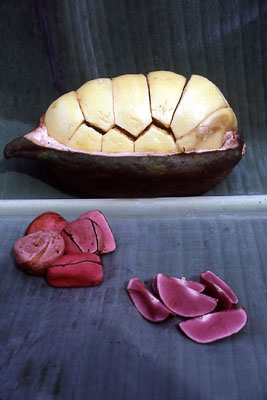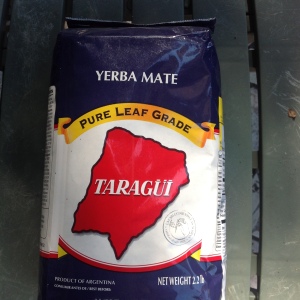Here are just a few plants consumed by mankind as a “stimulating beverage”. In this post, the focus is on plants containing caffeine and theobromine. Caffeine is an alkaloid found in over 60 species of vascular plants, and as we know, is an important ingredient of coffee, tea and other beverages.

Chemical formula for caffeine, an alkaloid.
The coffee beverage is derived from the roasted or baked seeds of two species of the coffee plant (Coffea arabica and C. canephora) of the family Rubiaceae. Tea is derived from the leaves of the tea plant (Camellia sinensis) of the family Theaceae, and chocolate is derived from seeds of a pod that springs directly from the trunk of the cacao tree (Theobroma cacao) of the Sterculiaceae. All three are woody shrubs or small trees commercially planted in the New and Old World Tropics and sub-tropics and all are descended from wild forest plants. Species of Coffea are native to Tropical Africa including the mountain forests of Ethiopia, Camellia sinensis to southeast Asia and cacao to tropical America. Note that the familiar camellia grown for its lovely flowers, is closely related to tea but of a different species of Camellia, C. japonica.
The center of biological diversity of coffee is primarily centered in the highlands of Ethiopia where deforestration is reducing gene pool diversity. Today most coffee is grown in Brazil, Columbia, Vietnam and Indonesia but over a million Ethiopian farmers also grow coffee. Growers everywhere rely on only a few cultivars for their plantations risking the loss of genes important in conferring resistance to parasites, diseases and climate change. Now that a draft genome for coffee has been achieved (Zamir 2014), developing methods for improving cultivar genetic diversity is more likely to be realized.
Coffee, tea and chocolate contain, among many other chemicals, alkaloids, which are essential to the flavor of the resultant beverages. Alkaloids are bitter, nitrogen-containing compounds found almost entirely in vascular plants. There are thousands of alkaloids, many (most?) toxic to insects, and many also exhibiting phytotoxic and anti-fungal properties. Many of these are also toxic to humans. (for more on alkaloids see the article entitled “Hold the Parsnips” under Plants elsewhere on this site).
Caffeine (1,3,7-trimethylxanthine) is perhaps the best known alkaloid by virtue of its association with coffee and tea. In a sequence of biochemical steps, enzymes in coffee plants convert a precursor compound called xanthosine into caffeine. The caffeine content of coffee is determined by the blending of beans of C. arabica, which contain relatively little caffeine, with that of C. canephora (Robusto), which contains relatively more caffeine.
As a brief aside, note that xanthosine is derived from the closely related compound, xanthine, and that xanthine can be found in meteorites. Meteorites of course, originate in outer space and many have collided with Earth. In 2011, analysis of a meteorite that landed in the Antarctic substantiated that the carbonaceous material such as xanthine that was found in the meteorite had to have been synthesized in outer space rather than just being a contaminant originating on Earth!
A second alkaloid universally present in coffee is trigonelline which occurs at only marginally lower concentrations than caffeine, but it is much less stable and degrades at roasting temperatures. However, one of its breakdown products is a group of compounds called pyridines which are major contributors to the distinctive flavor and aroma of brewed coffee. (coffeechemistry.com). Another major category of compounds in coffee is oils of which there are hundreds (e.g., lipids and triglycerides) and which also are principal contributors to coffee’s flavor and aroma.
Tea derives its flavor from caffeine, polyphenols and essential oils, the proportions of which vary with leaf age and method of processing picked leaves. Caffeine content of tea leaves can be up to three times that of C. arabica beans.
One of the intermediate steps involved in the conversion of xanthosine to caffeine produces theobromine, the main alkaloid in chocolate. Theobromine, in turn, is the precursor of caffeine. Similar biochemical steps yield caffeine in both the cacao tree and in tea but different antecedent genes and enzymes are involved. There must be something beneficial (adaptive) to storing caffeine in tissues or it would not have been selected for in unrelated plants. One hypothesis is based on the observation that the caffeine in senescing Coffea leaves inhibits the germination of seeds of other species. Thus caffeine-containing plants gain an advantage in the competition for nutrients, light and water. Another adaptation relates to pollination. Caffeine in the coffee plant is not restricted to seeds but is found throughout the plant, even in the nectar secreted by the coffee plant’s flowers. It turns out that bees resemble humans in that they “respond positively” to the caffeine in nectar, seeking it out and choosing flowers with caffeine over flowers lacking it. For other animal species, however, caffeine is a toxin capable of causing sterilization. The intense bitterness of caffeine and its high concentration probably are sufficient to deter insects seeking to consume the fleshy tissue enclosing the coffee seed within the fruit.
Chocolate is prepared from fermented cacao seeds of Theobroma cacao which are roasted and ground and often flavored with vanilla, sugar and sometimes fat. Besides T. cacao, the genus Theobroma includes 30 to 50 tropical American tree species that do not produce chocolate. Although Theobroma cacao is native to South America, almost half of the world’s commercial cocoa supply comes from a small area in west Africa, within 300 km of the coast in Ghana and the Ivory Coast. In these areas, based on some climate models, an average temperature rise of 2.3 C could occur by 2050. This warming would adversely affect the growth and respiration rates of Theobroma trees and effects could first appear as early as the year 2030 (Inter. Center for Trop Agric). However, other areas presently unsuitable for commercial chocolate production could, in response to the projected warming, become suitable for chocolate producers. The net effect of these shifts in cacao growing areas in coming decades is unclear.
Theobromine and caffeine are closely related and co-occur in many plant species besides cacao, including, at relatively low concentrations, members of the citrus family (Rutaceae). Theobromine is less addictive but is a stronger heart stimulant and vasodilator than is caffeine. The theobromine content of chocolate is low enough that ordinarily, toxic effects are not a concern for humans but it is highly toxic to dogs and cats. Cacao beans contain caffeine at concentrations varying from 0.1 to 0.7% while fats (cocoa butter) comprise over ½ by weight of the seed. There are 30-40 seeds (“beans”) in a pod. The pods are hard and fibrous providing some protection from wildlife but pods can be opened by rodents and monkeys which are attracted to the sweet pulp surrounding the seeds. Getting past the pod still requires that the marauder resist the astringent tannins abundant in the pods and, of course, the bitter alkaloids.
Caffeine also is an ingredient in forest trees of tropical West Africa belonging to the genus Cola of the Sterculiaceae and known as kola nut trees. The nut is the source of the caffeine used by humans as a stimulant and soft drink and as a treatment for asthma. Kola nuts contain about 2-3.5% caffeine and 1.0-2.5% theobromine and are still today chewed by many people in West Africa, presumably to enjoy the caffeine stimulation. The Cola genus consists of about 125 tree species of which two serve as the source of the kola nut- C. acuminata and C. nitida.
Yet another caffeine-containing plant is mate’ (yerba mate) which is consumed widely in Latin America especially in Uruguay and Argentina and to a lesser extent, in Spain and Portugal. Mate contains less than 1% by weight of caffeine. To prepare, leaves of Ilex paraguariensis (Ilex is the genus to which the hollies of North America and Europe belong; see below) are ground to a powder and steeped in hot water. Interestingly, in common with tea and many other plants, mate contains polyphenol antioxidants ( e.g., chlorogenic acid) that are recognized as having anti-cancer properties. However, drinking mate at very high temperatures may increase the risk of esophageal cancer, as might the imbibing of very hot tea. Otherwise mate is not presently classified as a carcinogen and is believed to confer some cardiovascular benefits to consumers.
Guarana’ (Paullinia cupana) of the Sapindaceae is a robust tropical liana which yields an herbal tea made from its seeds that have been ground to a powder. Guarana’ seeds are high (3.6-5.8%, or 2-4% depending on source) in caffeine compared to coffee (about 2%). The plant, native to the Amazon Basin, also contains smaller amounts of theobromine (200-400ppm). Like the other caffeine-containing plants, its fruits and seeds are known to repel herbivores.
Guarana’ tea is important in rituals of native peoples of South America and was already transported by 16th century explorers to Europe where it was soon consumed as a beverage. Currently, guarana’ is promoted as a dietary supplement that presumably boosts physical activity. Other species in the genus also are of interest. P. yoco , the bark and stem of which contains caffeine, is used by native peoples of Columbia and Ecuador in herbal medicines and to prepare a beverage. Two closely related species are very toxic-P. cururu of Central America and The Antilles and South America which produces a highly toxic sap that is used as an arrow poison by South American native peoples, and P. pinnata of South America and Africa, the stems of which are used to poison fish in pools and the roots and leaves of which are used in traditional medicines.
Huito or Jagua, (Genipa americana of the Rubiaceae), a widespread small tree of the Caribbean and Latin America, contains “very high amounts of caffeine in its seeds (botanical-online.com)” but it’s mainly the fruit that is consumed. The fruit of this species is used in drinks and in various dessert dishes, in skin decoration and for certain ailments. Some level of caffeine is likely present in the fruit but this is unverified.
The plant family Aquifoliaceae includes about 400 species, nearly all in the genus Ilex (holly). Besides yerba mate (above), other species in the genus have served as tea substitutes. Perhaps the most widely used in North America was Ilex vomitoria, the yaupon or cassina, a native shrub of the southern United States, especially common on sandy soils. The leaves of cassina have, according to Fernald et al. (1958), an “appreciable amount of caffeine, thus rendering…..them mildly stimulating”. Proper preparation involves kiln-drying of leaves followed by milling and steeping. Leaves of I. cassine, another holly of the southeastern US, also contains caffeine and reportedly makes a good tea. Other members of the genus, some of which lack caffeine, also are possible sources of a palatable tea.
Fernald, M.L., A. C. Kinsey & R. C. Rollins 1958. Edible Wild Plants of Eastern North America. Harper & Bros. New York.
Zamir, D. 2014. A wake-up call with coffee. Science 345:1124-1125.




